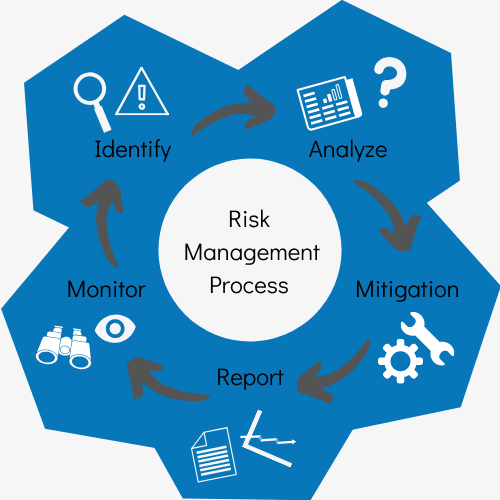A Comprehensive Guide to Understanding the Importance of Risk Management
A Comprehensive Guide to Understanding the Importance of Risk Management
Blog Article
Why the Relevance of Risk Management Can not Be Forgotten in Today's Economic situation
In today's swiftly developing economic landscape, the duty of Risk Management has become crucial. This elevates a crucial concern: can the significance of Risk Management in guaranteeing security and sustainability be neglected?
Comprehending the Principle of Risk Management

The Function of Risk Management in Today's Economy
Having actually realized the principle of Risk Management, we can currently explore its role in today's economic situation. Risk Management functions as an essential device for federal governments and businesses, permitting them to navigate operational and monetary uncertainties. Successful Risk Management can aid companies expect prospective dangers, enabling them to make enlightened choices and act proactively as opposed to reactively. Moreover, it assists in the allotment of sources, making certain that prospective losses are decreased while chances for growth are optimized. In the context of an uncertain financial landscape marked by fast worldwide occasions and technological changes, Risk Management ends up being a necessary tactical element, adding to the stability, sustainability, and general durability of economic climates on both a macro and micro scale.
The Impact of Overlooking Risk Management
Overlooking Risk Management can lead to alarming consequences for any kind of business or economy. The worldwide monetary crisis of 2008 offers as a raw tip of the disastrous impact that forgeting Risk Management can have on the economic climate at large. Thus, overlooking Risk Management not just endangers specific services but can destabilize the entire economic situation, underscoring the crucial duty played by effective Risk Management in today's financial landscape.
Key Parts of Reliable Risk Management Techniques
Effective Risk Management strategies focus on two essential elements: recognizing possible risks and applying mitigation actions. To ensure the security and sustainability of a company, these aspects ought to not be ignored. In the complying with conversation, these crucial facets will certainly be checked out carefully.
Recognizing Potential Risks
Why is identifying possible risks critical in any Risk Management method? Identification of potential dangers is the cornerstone of any reliable Risk Management approach. It includes the methodical evaluation of business landscape, both interior and external, to uncover threats that can thwart a company's strategic purposes. Identifying possible threats enables organizations to prepare for issues, instead of simply react to them. This proactive approach encourages services to handle uncertainty with confidence, by highlighting locations that need further attention and planning. It also allows them to focus on resources efficiently, concentrating on threats that can have one of the most considerable influence on their procedures. In general, the process of recognizing prospective dangers is a crucial action in promoting company resilience and advertising sustainable growth.
Implementing Reduction Steps
Navigating via the volatile company waters, organizations embark on the essential trip of executing mitigation actions as part of their Risk Management methods. These measures, designed to decrease the influence of possible dangers, create the backbone of a durable Risk Management strategy. They encompass numerous methods, consisting of moving the Risk to one more party, preventing the Risk, lowering the unfavorable result or probability of the Risk, or also approving some or all the effects of a specific Risk.

Situation Studies: Effective Risk Management in Technique
Regardless of the intricacies entailed, there are a number of circumstances of efficient Risk Management in practice that demonstrate its important role in service success. Boeing, the aerospace titan, managed to minimize the Risk of ever-changing currency prices article by hedging against the dollar utilizing ahead agreements. An additional example is Toyota's response to the 2011 Japan earthquake. The car manufacturer promptly established a risk Management team that decreased production downtime by identifying alternate providers. In the economic sector, Goldman Sachs weathered the 2008 economic crisis with a robust Risk Management program that prepared for the subprime mortgage crisis. These instances highlight that successful Risk Management can not only protect organizations from possible risks yet additionally allow them to seize chances.
Future Trends in Risk Management: Adjusting to a Dynamic Economic Situation
Looking in advance, the landscape of Risk Management is positioned for substantial adjustments as it adjusts to a vibrant economic situation. Technical improvements are expected to revolutionize the area, with automation and artificial knowledge playing a crucial duty in Risk recognition and reduction. At the same time, the enhancing complexity of global markets and the unpredictability of geopolitical occasions are making Risk Management more challenging.
Verdict
In final thought, Risk Management plays an important function you can try this out in today's interconnected and unpredictable economy. As the economic situation continues to progress, so have to risk Management methods, underscoring its recurring importance in an ever-changing organization landscape.
An appropriate Risk Management strategy is not concerning removing threats completely - an accomplishment virtually difficult in the unstable globe of that site service. Hence, neglecting Risk Management not only threatens specific services yet can undercut the whole economy, emphasizing the crucial duty played by reliable Risk Management in today's economic landscape.
Efficient Risk Management methods revolve around 2 vital components: determining potential threats and implementing mitigation steps.Why is recognizing prospective threats important in any type of Risk Management technique? They include numerous techniques, including moving the Risk to another party, staying clear of the Risk, minimizing the adverse effect or chance of the Risk, or also approving some or all the effects of a certain Risk.
Report this page